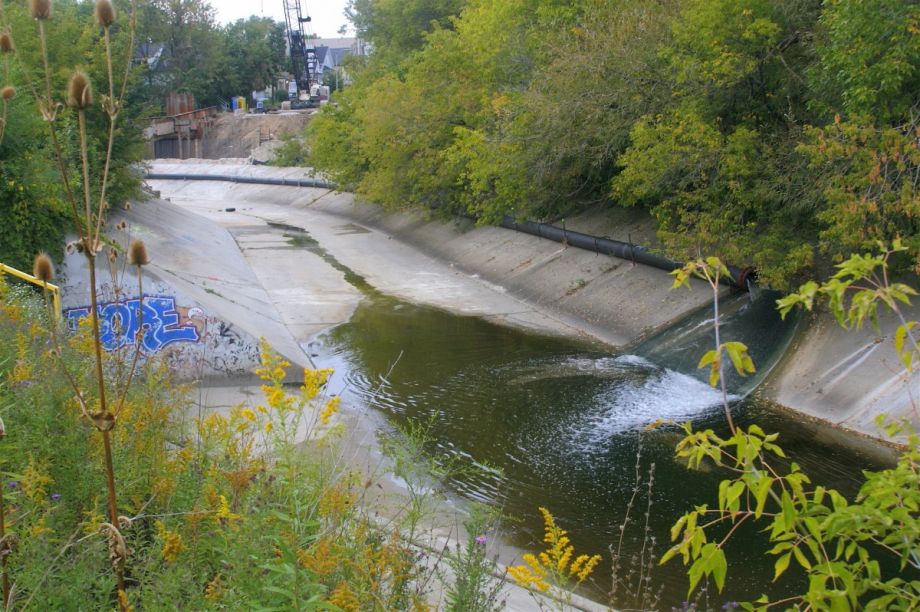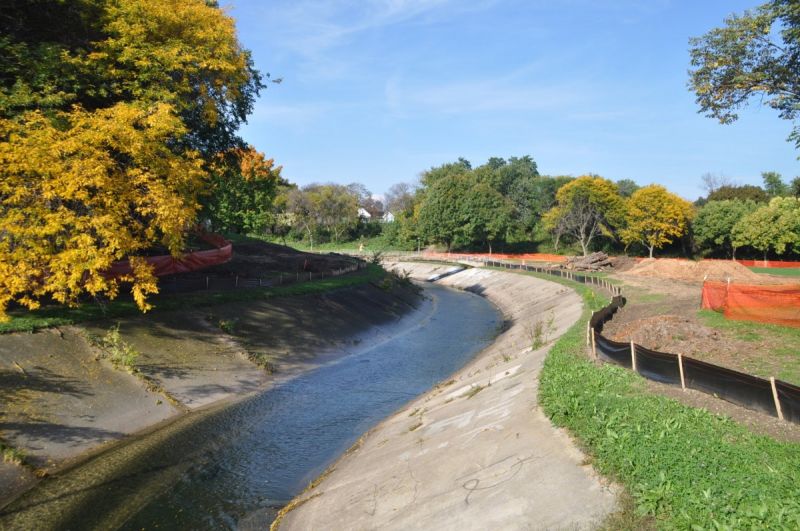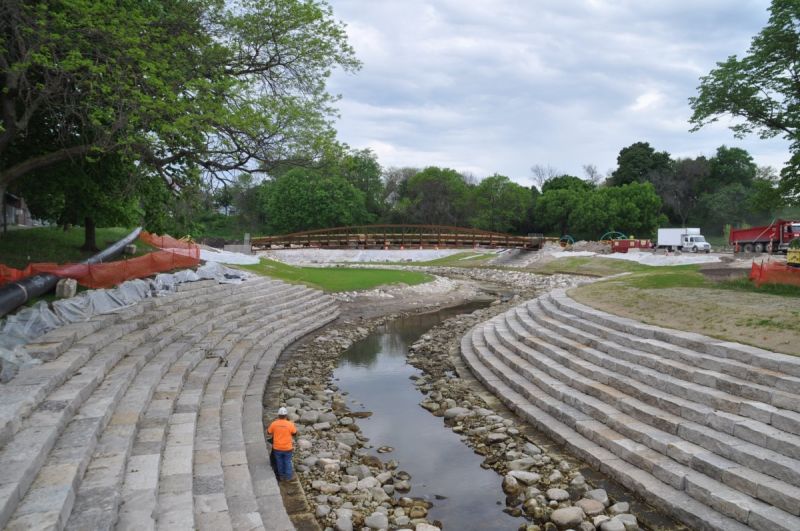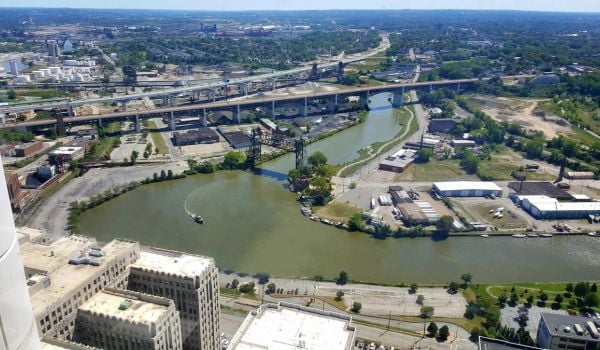Cities across the United States are evaluating their flood risks, and in some cases, they are finding that infrastructure installed in the 1960s and 70s is actually exacerbating flooding issues.
Milwaukee’s Kinnickinnic River, which locals call the “KK River,” is one of these. The smallest of three rivers that flow through Milwaukee into Lake Michigan, its 60s-era concrete lining has made flooding worse for neighbors who live in the area. Now, sewer district officials aim to return the river to its natural state, pulling out all seven miles of concrete and returning the riverbed to soil, rocks and vegetation. They’ve partnered with community health clinic Sixteenth Street Community Health Center to ensure that the project involves residents’ visions. The $390 million “rechanneling” process, which began ten years ago, is expected to last until 2035 and aims to reduce flooding, improve public health and safety and increase residents’ enjoyment of the river.
The 1960s were an era in which humans landed on the moon following a philosophy that we could impose our will on nature. The Kinnickinnic’s concrete lining stems from the same logic. The goal was to move flood water into Lake Michigan as quickly as possible. As a result, seven miles of the river now flow between narrow, concrete walls. That modification meant more homes could be built near the riverbanks, but it also increased the river’s rate of flow. At the time, the logic was that the faster you got heavy rains out of the urban environment, the better. Those modifications, however, meant that it was virtually impossible for anyone who fell into the river to clamber out. It also prevented the banks from absorbing water, therefore keeping it out of the sewer system. And, it failed to resolve flooding issues in adjacent areas of the Lincoln Village neighborhood through which it flows.
“If flood water gets in the basement of even one home, that can cause wide-scale basement backups and sewer overflows, and we don’t want that because that floor drain in a house [leads to] the sanitary sewer system,” says Bill Graffin, a spokesperson for the Milwaukee Metropolitan Sewer District. During intense rain events, water can overtop the Kinnickinnic’s artificial banks and spill into the basements of nearby homes. Flowing into basement drains, this water can end up causing the sewer to overflow, producing backups into other homes and businesses via their basement drains.
Over the past several years, Milwaukee has experienced several heavy rain events that have caused problems, says Patrick Elliott, the engineer who manages the Kinnickinnic revitalization project for the sewer district. For example, in 2009, Miller Park, home of the Milwaukee Brewers baseball team, flooded. The following year, the city sustained more than $30 million in damages, and beaches were closed because the sewer system had overflowed, flowing directly into the lake. As the rechanneling project got under way in 2009, Elliott says, the sewer district had to adjust its plan to better accommodate the increased likelihood of intense rainfall.
These floods can cause short-term damage like flooding basements and causing the sewer system to overflow, but there’s a more insidious effect: they also cause mold in basements and walls. Mold contributes to high asthma rates among Sixteenth Street’s child patients. Nearly 13 percent of kids seen at the organization’s clinics have it, significantly higher than the national average of 8.4 percent.
That’s why Sixteenth Street is interested in the rechanneling project.
In addition, the organization is working to ensure residents’ voices are heard during the process. All of Sixteenth Street’s staff speak Spanish in this predominantly Latino neighborhood, and this combined with the organization’s deep roots in the community is why the sewer district sought to partner with them to engage residents.
In turn, Sixteenth Street joined forces with KK River Neighbors in Action. Travis Hope, 40, is the organization’s president and a long-time neighborhood resident. “I’ve been trying to work on there to activate that green space and to do stuff in the park and to keep it connected to the neighborhood,” Hope says.
Together, KK River Neighbors and Sixteenth Street have knocked on more than 1,200 doors since April. This strategy complements picnics and pop-up events where, says Stephanie Mercado, the neighborhood revitalization manager for Sixteenth Street, use sewer district information about water quality and the environment to educate residents. Mercado says the aim is so “people are invested in that project and realize how it’s going to affect them.”
The sewer district and the health center have also piggybacked on KK River Neighbors’ monthly meetings to get information out about the concrete-removal project. “Aldermen come, the police come, different resources are in attendance, as well as neighbors that have concerns or questions. So that’s been a great way for us to get information out but also to take concerns back to [the sewer district],” Mercado says.
Not every community concern connects directly to the Kinnickinnic rechanneling project, yet Mercado sees a bigger picture of community health. For example, when a resident expresses concern about fast cars, Mercado sees a speed bump as increasing the likelihood that residents will cross the street and, consequently, exercise.
Elliott, of the sewer district, credits the agency’s executive director with the push to connect with community partners, but he is also pragmatic about the importance of these efforts. “If the community doesn’t see it as a success, if they don’t see the project as working, it’s tough to call it a success,” Elliott says.
Mercado and Hope both commented on the way residents are engaging with the fauna that are returning to the areas of the river where the concrete has already been removed. Salmon have been observed spawning downstream and traveling upstream to Pulaski Park, Mercado says. As a result, fishing becomes a real possibility. Likewise, a volunteer leads bird- and bat-walks and keeps track of migration patterns.
In that sense, Hope says the park is undergoing a transformation as more people use it as a space to walk and ride bicycles. “That’s what really changed,” he says. “There’s a nice trail that goes through there, because we got a grant from rails and trails,” he says. Now, one of the improvements the KK River Neighbors are considering for the park are painted lines on the ground that can indicate how far a certain route is, which would allow walkers and joggers to gauge how far they are traveling.
Elliott says that, as an engineer, this project has pushed him outside of his comfort zone and into connecting with the public. But he says, while coordinating with different partners adds complexity to the project, it also strengthens it by incorporating input from different groups. Working with a range of groups, Elliott says, “also [builds] more champions within these areas and these projects that will work towards carrying these messages forward to improve water quality.”
Gallery: Kinnickinnic Before and After
This story is part of The Power of Parks, a series exploring how parks and recreation facilities and services can help cities achieve their goals in wellness, conservation and social equity. The Power of Parks is supported by a grant from the National Recreation and Park Association.

Zoe Sullivan is a multimedia journalist and visual artist with experience on the U.S. Gulf Coast, Argentina, Brazil, and Kenya. Her radio work has appeared on outlets such as BBC, Marketplace, Radio France International, Free Speech Radio News and DW. Her writing has appeared on outlets such as The Guardian, Al Jazeera America and The Crisis.
Follow Zoe .(JavaScript must be enabled to view this email address)


















